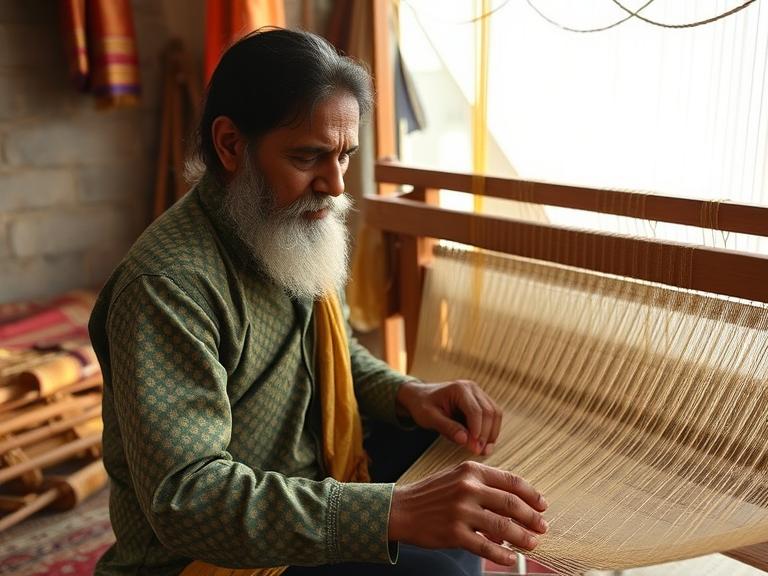Sonam
Share
Hands of Gold – A Banarasi Zari Artisan’s Journey

In the narrow, bustling lanes of Varanasi, where temples echo with chants and the Ganges flows with stories, lives Faizuddin, a Banarasi Zari artisan whose hands carry centuries of legacy. His loom doesn't just weave silk — it weaves golden dreams.
🧶 What Is Zari Work?
Zari is a fine gold or silver metallic thread traditionally used in Indian textiles to create intricate embroidery, especially in sarees. In Banaras, or Varanasi, the tradition of Zari weaving dates back to the Mughal era, when emperors draped themselves in grandeur.
Banarasi sarees are known for their opulence and intricacy — and Zari is what gives them that divine shimmer. “People think it’s just thread,” says Faizuddin, “but it’s the soul of the fabric.”
👴 A Legacy Passed Down
Faizuddin is a fourth-generation artisan. His father wove for royals, his grandfather for Mughal patrons. “We don’t just make sarees,” he says. “We carry our history.”
He learned the art at the age of 12, sitting beside his father, absorbing the rhythms of the loom like a song. Now in his 50s, Faizuddin continues the legacy with patience, pride, and a deep sense of purpose.
Each saree can take up to 30 days or more, depending on the design. Some intricate bridal pieces can take months. “It’s not just work,” he says, “it’s worship.”
✨ Gold That Glows Without Greed
Traditional Zari was made by flattening gold or silver into thin wires, then wrapping them around silk threads. Today, real metal Zari still exists — especially for premium collections — while some artisans use imitation Zari to make the art more affordable.
Faizuddin still uses pure Zari for custom heirloom pieces. He sits on a small wooden bench, his feet controlling the warp threads, while his hands guide the weft. The golden threads glimmer with every movement. It's slow. It’s exacting. But it’s magical.
🌍 A Global Audience
With the growing popularity of Indian textiles abroad, Faizuddin’s creations have adorned brides in New York, London, and Dubai. Collaborating with fashion designers and heritage collectives, his sarees are now shipped globally.
“My sarees have crossed oceans,” he beams. “But they all begin here — under this roof, with my loom.”
His son, Ayaan, a design graduate, helps him digitize patterns and connect with buyers online. “We want to keep the tradition alive,” Ayaan says, “but we also want to adapt.”
🛕 Cultural and Spiritual Significance
Zari work is more than just decoration — it’s sacred. In Hindu weddings, Banarasi sarees with real Zari are considered auspicious. In Muslim traditions, they are gifted during Eid and weddings.
The motifs — kalga (paisley), bel (floral creeper), and jhallar (border tassels) — often carry religious meanings and blessings.
“We don’t just weave fabric,” Faizuddin says. “We weave moments — of prayer, of joy, of family.”
👨👩👧👦 Empowering the Artisan Community
Zari weaving is labor-intensive and often underpaid. Faizuddin now works with artisan cooperatives to ensure fair wages, skill development, and apprenticeships. “We don’t want our children to leave this art behind,” he says.
With support from NGOs and fair-trade platforms, the younger generation is now seeing the value — not just cultural, but financial — of sustaining the craft.
💫 Beyond Sarees: Modern Applications
Today, Zari embroidery is being used beyond sarees — in dupattas, bags, jackets, and home décor. Designers are experimenting with eco-friendly metallic threads and contemporary color palettes while still honoring the traditional designs.
“It’s exciting,” Faizuddin says. “It’s like giving old gold a new shine.”
🌱 A Future Rooted in the Past
Faizuddin dreams of opening a Banarasi Zari School where young weavers can learn, innovate, and grow — without forgetting where they come from.
“Our craft is like the Ganga,” he says. “Ancient, flowing, always giving.”
💖 Why Supporting Zari Artisans Matters
When you choose a Banarasi product made with authentic Zari:
- You’re preserving a centuries-old tradition.
- You’re supporting livelihoods of skilled artisans.
- You’re investing in textile art that tells a story of culture and craft.
🌟 Final Thoughts
Faizuddin’s golden threads do more than sparkle — they stitch together the sacred, the celebratory, and the soulful. In his quiet workshop, amidst spools and silks, the past lives on… not in museums, but in living, breathing fabric.
Because in Banaras, the divine is not just worshipped — it’s woven.
Related articles
The Loom of Legacy: Weaving Stories in Kanchipuram Silk
In the temple town of Kanchipuram, master weaver Raghavan keeps centuries of silk weaving tradition alive — crafting sarees that...
Stitched with Pride: The Mirror Work of Gujarat’s Rabari Women
In the deserts of Kutch, Gujarat, the Rabari women stitch more than fabric — they stitch identity, tradition, and soul....






